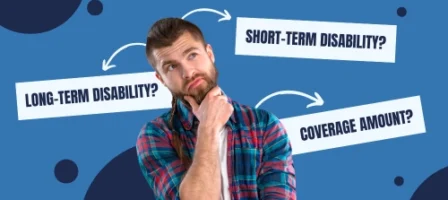Long-term disability insurance (LTD) is a critical but often misunderstood aspect of financial planning. It…

Lawyers With Disabilities Battle More Than We Think
Think about it. When was the last time you saw a lawyer with a disability? And no, Netflix’s legally-blind Daredevil “Matt Murdock,” doesn’t count.
For years it has been touted that prior to the age of retirement, one out of every four working-age Americans will become diagnosed with a Long-Term Disability at some point in their career. So, if that is true, how is it that there are so few lawyers with disabilities?
Not All Disabilities Are Visible
When we initially think of a disability, our mind immediately tends to gravitate towards those in wheelchairs or walking with a cane, but there are a number of disabilities that are invisible to the eye but can be every bit as difficult to manage.
According to the 1994-1995 Survey of Income and Program Participation (SIPP) roughly 1 out of every 10 Americans is recorded as having a severe disability— in today’s numbers, that translates to 32.57 million people. In the nineties it was found that out of those 1 in 10 Americans with disabilities over 74% of them did not use any assistive devices making their disability invisible to strangers.
The most often cited examples of these so-called invisible disabilities are:
- Chronic Pain (including fibromyalgia)
- Chronic Fatigue
- Mental Illness
- Chronic Dizziness
So, with over 1.3 million lawyers practicing in the United States (as of 2016), how is it that so few appear to struggle with disabilities?
Lawyers And The Disability Stigma
According to a 2015 Terry Carter article featured in the ABA Journal, Max Brittain, a prominent management employment litigator in a 400-lawyer firm who just so happens to be disabled said, “‘There is a stigma attached to something when people really don’t know much about it…getting them to come forward is the biggest issue.”
According to the American Bar Association (ABA), the truth is “The number of lawyers with disabilities is hard to determine. Unlike race, gender, ethnicity and, more recently, sexual orientation, there is little reporting on them. Only two state bars—those in Oregon and Washington—have done tallies, and still that is self-reporting. Some lawyers won’t do so; some others don’t see themselves as disabled. And the definition of disability under the Americans with Disabilities Act is fast expanding…”
Also mentioned is a Stuart Pixley, a senior attorney at Microsoft Corp., who previously worked at three large law firms, has cerebral palsy and uses an electric wheelchair and hearing aids. On the subject of lawyers with disabilities, Pixley had this to say: “We’re still often looked at as a delicate flower or damaged, and that makes it hard to be part of the diverse fabric of the workforce.”
Pixley himself has encountered numerous instances where colleagues didn’t know how to respond to his challenges and at times led to not just his own embarrassment, but also had a perceived negative impact on his overall acceptance as a team member and even partner within the firm. Pixley’s disabilities led to his colleagues questioning his capabilities when no complaints had even been issued.
As It Stands Today
The passage of the American’s With Disabilities Act in 1990 saw many reforms in regard to increasing accessibility, awareness, and even overall acceptance of people who struggle with disabilities. In 2006 the Disability Rights Bar Association launched followed by the National Association of Attorneys with Disabilities and the National Association of Law Students with Disabilities in 2007, and then the ABA Commission on Disability Rights in 2009 where the Disability Diversity in the Legal Profession: A Pledge for Change was written.
The pledge was significant because it signified a commitment to ensure lawyers with disabilities are given a fair chance in their respective professions, and better reflect the diversity of communities, clients, and their customers. As of 2015, the pledge boasted over 175 signatures including those of law firms, law schools, corporations, organized bar groups, and more.
But while an increasing amount of firms are working to honor this pledge and hire lawyers with the traditionally thought of disabilities, such as vision, auditory, and mobility difficulties, many still appear to be having difficulties dealing with the seemingly invisible disabilities related to the mind such as depression, anxiety, bipolar, etc. The fact that these issues are often-times completely treatable and manageable is still often overshadowed by the existence of social stigma as well as a general lack of understanding.
In short, many firms and hiring managers appear to be quick to worry about client feelings as well as what the lawyer can’t do, rather than what they can.
Planning For The Future
Attitudes and perceptions have seemingly always been an obstacle to overcome and while there has been a growing movement with many law firms directing more attention to giving lawyers who struggle with a disability more opportunity, progress can always be made.
As of 2015, The National Association for Law Placement was recorded as finding “that just one-third of 1 percent of law firm partners reported having disabilities in its 2014 survey, which was slightly higher than a few years earlier. Associates with disabilities composed just 0.28 percent, also slightly higher than before.”
And with the number of law students requesting additional accommodations for those with disabilities, the previously noted totals are only expected to rise leaving many firms to reassess and confront their perceptions of perceived ability.
Just because no one can predict the future, doesn’t mean you shouldn’t still plan for it and now is the perfect time to do it because May is National Disability Insurance Awareness Month.
If you wish to receive more information about how you can safeguard your financial future in the event of being diagnosed with a long-term disability, please visit our LTD page to view the complete Long-Term Disability brochure or to download an application.


